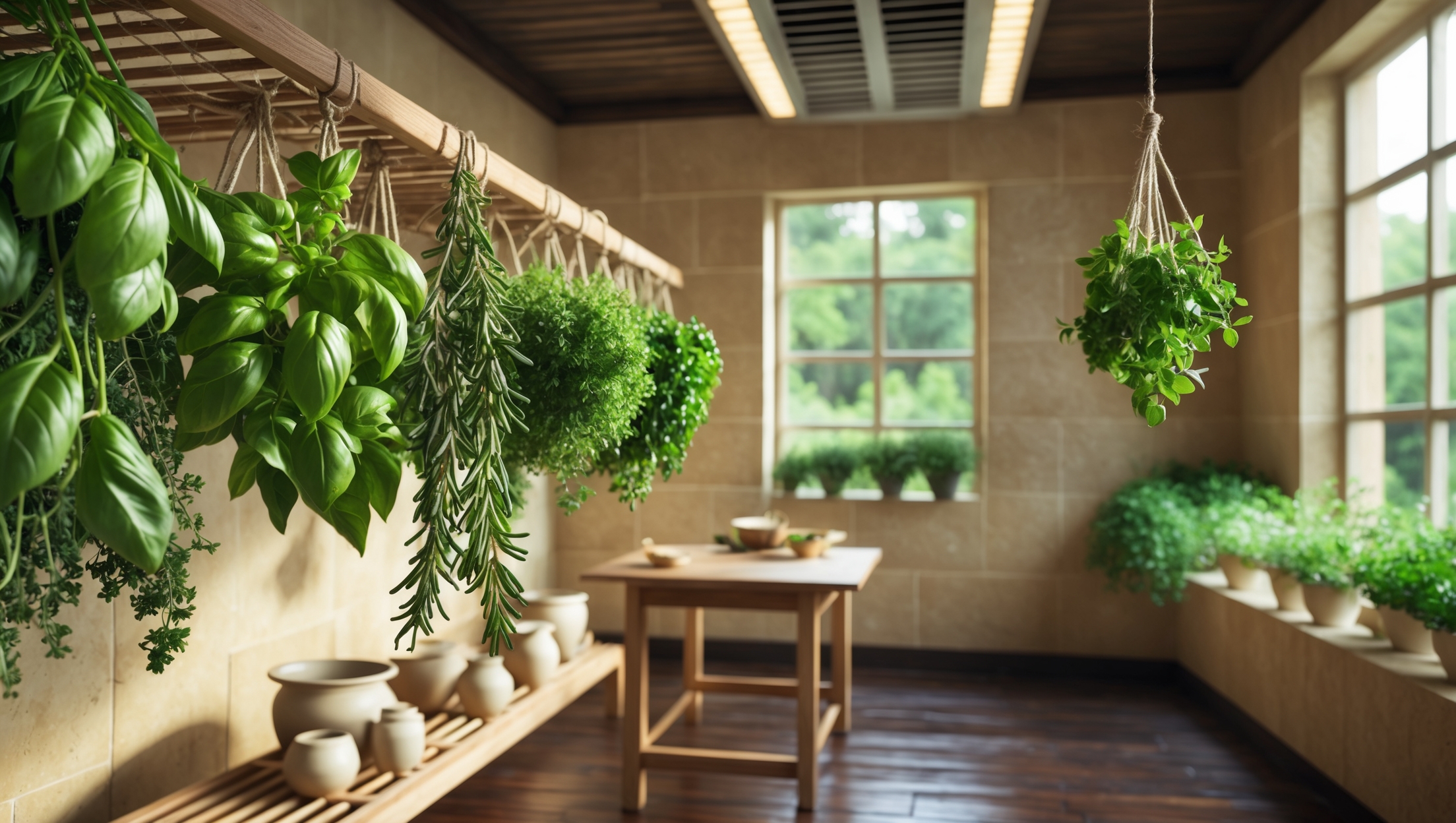Introduction: Why a Home Herb Drying Room?
Drying your own herbs at home is a rewarding way to preserve the flavors and aromas of your garden bounty or farmer’s market finds. Whether you’re passionate about culinary herbs, medicinal plants, or fragrant botanicals for teas and crafts, a dedicated home herb drying room offers the control and consistency that kitchen counters and makeshift setups simply can’t match. However, many first-timers make critical mistakes that lead to moldy leaves, faded flavors, or even wasted harvests. Setting up a proper herb drying room requires planning, attention to environmental factors, and an understanding of the unique needs of different herbs. In this guide, we’ll delve into the most common beginner mistakes when launching a home herb drying room and provide practical, actionable advice to ensure you get perfectly preserved herbs every time.
Choosing the Wrong Location
Ignoring Temperature and Light Requirements
One of the most frequent errors is selecting a space that is too warm, too cold, or exposed to direct sunlight. Most herbs require temperatures between 60–70°F (15–21°C) for optimal drying. Spaces that get too hot can cause herbs to dry too quickly, leading to loss of flavor and essential oils. Sunlight will bleach leaves, degrade active compounds, and result in poor-quality dried herbs.
- Tip: Choose a cool, dark, and well-ventilated room—such as a spare closet, unused bathroom, or basement corner away from windows.
- Tip: Avoid attics and garages where temperature and humidity can fluctuate wildly.
Overlooking Airflow and Moisture Risks
Poor air circulation is a recipe for disaster, as it encourages mold growth and uneven drying. Similarly, high humidity can result in limp, musty herbs that are unsafe to consume.
- Tip: Select a space with access to cross-ventilation or install a small fan for gentle air movement. Never aim the fan directly at the herbs.
- Tip: Use a hygrometer to monitor humidity; aim for 45–55% relative humidity for most herbs.
Improper Preparation of Herbs
Washing Mistakes
Some beginners skip washing, which can leave behind dirt, insects, or garden chemicals. Others overwash, soaking tender leaves and encouraging rot during drying.
- Tip: Rinse herbs gently under cool water only if necessary, then shake off excess moisture and pat dry carefully with towels.
- Tip: Never place dripping-wet herbs in the drying room. Surface moisture is the enemy of successful drying.
Harvesting at the Wrong Time
Harvesting herbs too late in the day, after rainfall, or after flowering can result in diminished oils and muted flavors.
- Tip: Harvest in the early morning after dew has evaporated but before the sun is too strong.
- Tip: Pick before flowering for the most potent leaves (except for seeds, which require flowering and drying).
Poor Drying Setups
Overcrowding
Stuffing too many herbs in a small space or bundling them too tightly prevents air from reaching all surfaces, increasing the risk of mold and uneven drying.
- Tip: Space bundles at least several inches apart on racks or lines. Avoid large, thick bundles.
- Tip: For leafy herbs, use mesh drying racks or trays in a single layer for optimal airflow.
Using Non-Food-Safe Materials
Some new herb dryers use old newspapers, plastic bags, or painted wire, which can leach chemicals or transfer unwanted odors to the herbs.
- Tip: Use food-grade mesh, uncoated natural fibers (like cotton or hemp twine), and stainless steel or untreated wood for racks and hangers.
- Tip: Avoid any materials with paint, varnish, or strong odors.
Neglecting Environmental Control
Humidity Problems
High humidity is the enemy of herb drying. Many beginners don’t realize how quickly rising humidity can cause mold or prolonged drying times.
- Tip: Use a small dehumidifier in high-humidity climates or during the summer months.
- Tip: If the room is too dry (below 30% RH), herbs may lose aroma and color. Use a shallow pan of water to add minimal moisture if needed.
Ignoring Air Exchange
Sealing the room too tightly in an effort to keep out dust can trap moisture and stale air, undermining the drying process.
- Tip: Allow for periodic air exchange by cracking a window or using a fan with an outside vent.
Poor Monitoring and Timing
Not Checking Regularly
It’s tempting to hang up your herbs and forget about them for a week, but this can lead to disaster if mold or over-drying occurs.
- Tip: Check herbs daily for signs of mold, uneven drying, or loss of aroma. Adjust airflow or remove fully dried bundles promptly.
Improper Drying Duration
Guessing at drying times is a classic mistake. Different herbs and environmental conditions require different durations.
- Tip: Most leafy herbs take 5–10 days. Flowers and seeds may require up to two weeks. Stems should snap cleanly when bent, and leaves should crumble easily but retain color.
Storing Dried Herbs Incorrectly
Using the Wrong Containers
Plastic bags, unsealed jars, or reused food containers can let in air, moisture, or odors, compromising your hard work.
- Tip: Store dried herbs in glass jars with airtight seals, ceramic canisters, or metal tins lined with food-safe material.
- Tip: Avoid clear containers if they will be exposed to light; sunlight fades herbs quickly.
Forgetting to Label and Date
It’s easy to forget which jar contains which herb—especially after a few months.
- Tip: Label each container with the herb name and drying date. Use painter’s tape or removable labels so you can reuse jars next season.
Not Cleaning and Maintaining the Drying Room
Skipping Post-Harvest Cleanup
Herb fragments, dust, and pollen can build up, attracting pests or contaminating future batches.
- Tip: Thoroughly sweep and wipe down surfaces, racks, and fans after each drying cycle. Inspect for signs of mold or insects.
Neglecting Equipment Checks
Fans, dehumidifiers, and humidity monitors can fail over time, leading to unnoticed problems.
- Tip: Test and clean all equipment before every use. Replace batteries and filters as needed.
Special Considerations for Different Herbs
Woody vs. Leafy Herbs
Woody herbs like rosemary and thyme are more forgiving and dry well in bundles, while leafy herbs (basil, mint, parsley) require extra care to prevent wilting.
- Tip: For leafy herbs, consider using mesh trays or screens instead of bundling. Turn leaves midway through drying for even results.
Flowers and Seeds
Drying edible flowers (like chamomile or calendula) and seeds (like coriander or dill) requires gentler airflow and more frequent checks.
- Tip: Use a fine mesh or cheesecloth to catch small petals or seeds as they dry and fall.
Final Quality Check
Testing for Proper Dryness
Don’t rely on guesswork. Herbs must be fully dry to avoid spoilage in storage.
- Tip: Leaves should crumble between your fingers; stems should snap, not bend. Seeds should be hard and rattle when shaken in a jar.
- Tip: If in doubt, dry for an extra day or two—slightly overdried herbs are better than risking mold.
Conclusion: Enjoying Your Perfectly Dried Herbs
Embarking on the journey of setting up a dedicated home herb drying room can be one of the most satisfying projects for any culinary enthusiast, herbalist, or home gardener. By recognizing and avoiding these common beginner mistakes—from choosing the right location and preparing herbs properly to maintaining the ideal drying environment and storing your harvest with care—you’ll ensure that your dried herbs retain their maximum flavor, color, and potency. Not only will you enjoy better-tasting meals and more aromatic teas, but you’ll also have the confidence that your preserved herbs are safe and free from contaminants.
Remember, the key to success lies in attention to detail at every stage: monitor temperature and humidity, provide adequate airflow, and never rush the process. With a little patience and regular maintenance, your home herb drying room will become an invaluable asset, allowing you to savor the essence of your garden all year round. Happy drying!


How long does it usually take for herbs to dry in a properly set up room with the right temperature and airflow? I want to plan my harvest around the drying time.
In a well-prepared drying room with good airflow and temperatures around 60 to 70 degrees Fahrenheit, most herbs take about 1 to 2 weeks to dry thoroughly. Thicker herbs might need closer to two weeks, while delicate ones can finish sooner. Checking for crispness in the stems is a good way to tell they are ready.
The article says not to point fans directly at the herbs. Why is that, and how close should the fan be to provide good airflow without risking damage or uneven drying?
Pointing fans directly at the herbs can cause them to dry too quickly or unevenly, which may affect their flavor, color, and potency. It can also blow leaves off delicate herbs. Position the fan so it circulates air gently around the room rather than right at the plants. Placing the fan a few feet away and angling it toward a wall or the room center usually works best.
You mention avoiding attics and garages because of temperature and humidity fluctuations. Are there any specific signs or measurements I should look for to know if a room is truly stable enough before using it for herb drying?
To check if a room is stable enough, use a thermometer and hygrometer to monitor temperature and humidity for at least a week. Look for readings that stay consistently between 60–70°F and 45–55% humidity. Watch for sudden changes or big swings throughout the day—these are red flags that the environment may not be stable enough for drying herbs.
Could you clarify what to do if the only available space for a drying room in my house is occasionally exposed to indirect light, like a basement with small windows? Would blackout curtains be enough to protect the herbs, or do I need something more?
If your drying space gets occasional indirect light, blackout curtains are usually a good solution to keep herbs protected from light exposure. Just make sure they fit snugly and block out all light, especially during the drying process. You can also use thick cardboard or heavy fabric as an extra layer if needed to ensure complete darkness.
I’m wondering if there are any budget-friendly ways to improve ventilation in a small closet without installing a permanent fan. Would just opening the door periodically be enough?
Opening the closet door regularly can help improve airflow, but it’s not always enough for proper ventilation, especially if humidity builds up. You could try using a small, portable desk fan placed near the open door to increase air movement without any permanent installation. Even propping the door open with a box or wedge can help fresh air circulate more consistently.